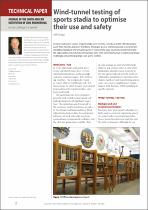JavaScript is disabled for your browser. Some features of this site may not work without it.
- ResearchSpace
- →
- Research Publications/Outputs
- →
- Journal Articles
- →
- View Item
| dc.contributor.author |
Goliger, Adam M

|
|
| dc.date.accessioned | 2010-09-28T08:44:56Z | |
| dc.date.available | 2010-09-28T08:44:56Z | |
| dc.date.issued | 2010-04 | |
| dc.identifier.citation | Goliger , AM. 2010. Wind-tunnel testing of sports stadia to optimise their use and safety. ournal of the South African Institution of Civil Engineering (SAICE), Vol. 52(1), pp 28-35 | en |
| dc.identifier.uri | http://hdl.handle.net/10204/4370 | |
| dc.description | Copyright: 2010 South African Institution of Civil Engineering | en |
| dc.description.abstract | In recent years large-scale global sports events and related ventures have received significant international media coverage and socio-economic support from the hosting countries. This is especially evident in respect of all recent Olympic and FIFA tournaments for which in many cases several large and innovative sports facilities have been constructed. Owing to their size, these structures generate wind-related environment and loading interactions of significant magnitude. The interactions are determined by the structures' architectural form, as well as by the climatic and local conditions. Wind-related interactions include the environmental impact of wind within the structures' surroundings, environmental conditions over the pitch and grandstands, and the effect of wind loadings on roofs and other large elements (e.g. curtain walls). In view of the implications of failure, most, if not all, of the new sports stadia all over the world are subjected to comprehensive specialist wind studies, based on wind-tunnel testing and, in some cases, also to supplementary computational fluid dynamics (CFD) modelling of specific elements. | en |
| dc.language.iso | en | en |
| dc.publisher | South African Institution of Civil Engineering | en |
| dc.subject | Wind-tunnel testing | en |
| dc.subject | Sports stadia | en |
| dc.subject | Stadia design | en |
| dc.title | Wind-tunnel testing of sports stadia to optimise their use and safety | en |
| dc.type | Article | en |
| dc.identifier.apacitation | Goliger, A. M. (2010). Wind-tunnel testing of sports stadia to optimise their use and safety. http://hdl.handle.net/10204/4370 | en_ZA |
| dc.identifier.chicagocitation | Goliger, Adam M "Wind-tunnel testing of sports stadia to optimise their use and safety." (2010) http://hdl.handle.net/10204/4370 | en_ZA |
| dc.identifier.vancouvercitation | Goliger AM. Wind-tunnel testing of sports stadia to optimise their use and safety. 2010; http://hdl.handle.net/10204/4370. | en_ZA |
| dc.identifier.ris | TY - Article AU - Goliger, Adam M AB - In recent years large-scale global sports events and related ventures have received significant international media coverage and socio-economic support from the hosting countries. This is especially evident in respect of all recent Olympic and FIFA tournaments for which in many cases several large and innovative sports facilities have been constructed. Owing to their size, these structures generate wind-related environment and loading interactions of significant magnitude. The interactions are determined by the structures' architectural form, as well as by the climatic and local conditions. Wind-related interactions include the environmental impact of wind within the structures' surroundings, environmental conditions over the pitch and grandstands, and the effect of wind loadings on roofs and other large elements (e.g. curtain walls). In view of the implications of failure, most, if not all, of the new sports stadia all over the world are subjected to comprehensive specialist wind studies, based on wind-tunnel testing and, in some cases, also to supplementary computational fluid dynamics (CFD) modelling of specific elements. DA - 2010-04 DB - ResearchSpace DP - CSIR KW - Wind-tunnel testing KW - Sports stadia KW - Stadia design LK - https://researchspace.csir.co.za PY - 2010 T1 - Wind-tunnel testing of sports stadia to optimise their use and safety TI - Wind-tunnel testing of sports stadia to optimise their use and safety UR - http://hdl.handle.net/10204/4370 ER - | en_ZA |






